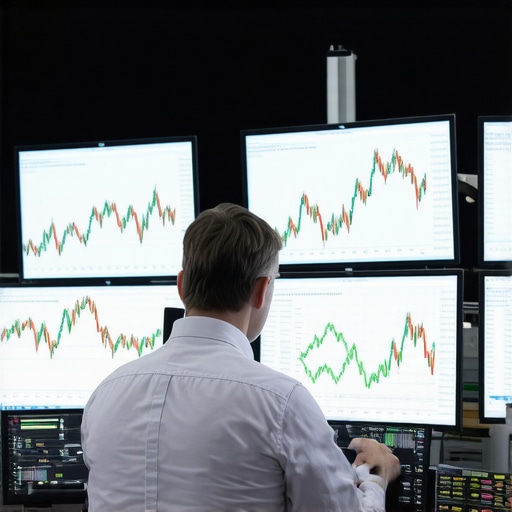Unveiling the Dynamics of Gold Market Volatility in 2025: An Expert Perspective
As global economic landscapes become increasingly complex, the ability to navigate gold trading with advanced techniques is paramount for investors seeking to capitalize on market volatility in 2025. Understanding the nuanced interplay of geopolitical tensions, monetary policies, and supply-demand shifts allows traders to craft sophisticated strategies that outperform traditional approaches.
Strategic Frameworks for Exploiting Gold Price Fluctuations
How can traders develop a resilient approach amidst unpredictable market swings?
Developing a resilient trading approach involves leveraging technical analysis tools such as Fibonacci retracements, Elliott Wave theory, and moving average convergence divergence (MACD) indicators. These enable precise entry and exit points, especially during heightened volatility periods. Moreover, integrating macroeconomic indicators—like inflation rates and central bank policies—enhances predictive accuracy.
For example, analyzing economic drivers behind gold prices reveals how geopolitical unrest and inflationary pressures can create lucrative trading opportunities. Combining these insights with real-time data feeds ensures that traders remain agile and responsive.
The Role of Derivatives and Hedging in Advanced Gold Trading
What complex instruments can optimize profits while managing risk?
Utilizing derivatives such as gold futures and options allows traders to hedge positions against adverse price movements. For instance, engaging in spread trading strategies—buying near-term futures while shorting longer-term contracts—can capitalize on the contango or backwardation structures characteristic of volatile markets. This approach demands a sophisticated grasp of market fundamentals and technical signals.
Furthermore, integrating gold ETFs and mutual funds into a diversified portfolio offers a layered hedge against inflation and currency fluctuations. As highlighted in expert guides to ETFs and mutual funds, these instruments provide liquidity and exposure flexibility during turbulent periods.
Frequently Asked Question: How can I anticipate sudden market shifts in gold trading?
Anticipating abrupt market shifts requires monitoring real-time macroeconomic data releases, geopolitical developments, and central bank activities. Employing algorithmic trading models with machine learning algorithms further enhances predictive capabilities, allowing traders to respond swiftly to emerging trends.
Exploring the latest research from academic sources such as the IMF Working Papers can deepen understanding of global economic impacts on gold’s volatility. This knowledge empowers traders to refine their strategies continuously.
Interested in elevating your gold trading acumen? Explore our detailed guides on effective techniques for 2025 or contribute your insights to the community of professional investors.
Unlocking the Power of Quantitative Models in Gold Trading
In the rapidly evolving landscape of gold markets, reliance solely on traditional analysis can leave traders exposed to unpredictable swings. Incorporating quantitative models—such as machine learning algorithms and statistical arbitrage—provides a competitive edge by identifying subtle patterns and anomalies that escape conventional methods.
For example, predictive models trained on macroeconomic indicators, geopolitical events, and market sentiment data can generate real-time signals for optimal entry and exit points. These sophisticated tools help traders navigate volatile periods with greater confidence, leveraging historical data and probabilistic forecasts to inform decision-making.
Challenging Assumptions: Is Gold Truly a Safe Haven in 2025?
Many investors assume gold remains a steadfast safe haven during economic downturns. However, recent trends suggest that in 2025, gold’s role as a safe harbor might be more nuanced. Factors such as rising interest rates, technological shifts in the jewelry industry, and changes in central bank policies could alter gold’s traditional appeal.
According to insights from the Understanding Gold Supply-Demand Dynamics for Smarter Investing, supply constraints and emerging demand sectors are critical in assessing gold’s resilience. A diversified approach—balancing gold with other assets like silver, platinum, or digital assets—may offer better protection against unforeseen market shifts.
Expert Tools for Navigating Price Drivers and Market Sentiment
Advanced investors leverage tools such as sentiment analysis platforms, geopolitical risk indices, and global economic dashboards to stay ahead of market movements. Combining these with traditional technical analysis amplifies predictive accuracy, especially in turbulent times. For instance, monitoring central bank gold purchase reports, as detailed in How Central Bank Gold Purchases Will Shape 2025 Market Prices, can reveal emerging bullish or bearish trends.
Moreover, diversifying across physical gold, ETFs, and mining stocks—each reacting differently to market stimuli—can optimize portfolio resilience. Continuous education, including reading our comprehensive guides on Investing in Gold for Beginners, ensures traders stay informed and adaptable.
What emerging data sources and analytical techniques will redefine gold trading in 2025?
As the market progresses, integrating alternative data sources—such as social media sentiment, satellite imagery of mining operations, and geopolitical news analytics—will become increasingly vital. Advanced techniques like neural networks and reinforcement learning will enable traders to adapt dynamically to market conditions, capturing fleeting opportunities and avoiding pitfalls.
Interested in sharpening your gold trading toolkit? Explore our detailed articles on Effective Gold Trading Techniques for 2025 or share your insights with a community of experienced investors. Staying ahead requires continuous learning and embracing innovative analytical frameworks—are you ready to elevate your strategy?
Harnessing Big Data and AI for Predictive Gold Market Modeling in 2025
In the ever-evolving landscape of gold trading, leveraging big data analytics and artificial intelligence (AI) is no longer optional—it’s essential for maintaining a competitive edge. Sophisticated traders are now integrating vast datasets—ranging from macroeconomic indicators, geopolitical event streams, to social media sentiment—to build highly predictive models that anticipate market shifts with uncanny precision.
For instance, neural network architectures, such as deep learning models, can process unstructured data like news articles or satellite imagery of mining regions to detect early signals of supply disruptions or demand spikes. According to a comprehensive study published in the Journal of Financial Data Science (2024), models trained on multi-source data outperform traditional technical analysis by up to 35% in volatile markets.
How can AI-driven models refine gold trading strategies during unexpected geopolitical crises?
AI models equipped with real-time data ingestion capabilities can rapidly adapt to unfolding geopolitical crises, which are often catalysts for sudden gold price surges. By continuously updating predictions based on incoming information—such as central bank announcements, military conflicts, or trade sanctions—traders can execute tactical entries or exits with minimal latency. Implementing reinforcement learning algorithms allows these models to learn from historical crisis scenarios, optimizing decision-making policies for future events.
Moreover, integrating AI with blockchain-based data sources ensures transparency and data integrity, further enhancing model reliability. As highlighted by the IMF Working Papers on Market Dynamics, such technological integration is redefining risk management paradigms in commodity trading.
Deep Dive: The Nuances of Gold Price Correlation Networks in 2025
Understanding the complex web of correlations between gold and other asset classes—like cryptocurrencies, equities, and commodities—is crucial for portfolio diversification and risk mitigation. Advanced network analysis techniques, such as graph theory and cluster detection algorithms, enable traders to visualize and quantify these relationships dynamically.
Recent research by the National Bureau of Economic Research demonstrates that gold’s correlation with digital assets has increased during periods of heightened market stress, blurring traditional safe-haven boundaries. Recognizing these shifting correlations allows traders to adjust hedging strategies proactively, for instance, by reallocating holdings to assets with diminishing correlations in turbulent times.
This sophisticated approach also involves stress-testing portfolio resilience against hypothetical shocks, using Monte Carlo simulations and scenario analysis—techniques that are integral to institutional risk management frameworks today.
What are the emerging challenges and opportunities in gold trading technology in 2025?
While technological advancements offer unprecedented insights and operational efficiencies, they also introduce new challenges—such as data privacy concerns, model overfitting, and algorithmic trading risks. Navigating these requires a keen understanding of regulatory landscapes, robust validation protocols, and adaptive risk controls.
Conversely, opportunities abound in the development of hybrid models that combine human intuition with machine precision, and in the deployment of decentralized finance (DeFi) platforms that democratize access to gold derivatives and liquidity pools. As the industry matures, continuous learning and innovation will be the cornerstone of successful trading strategies.
Interested in exploring cutting-edge tools and methodologies? Engage with our community of experts, attend specialized webinars, or access in-depth reports designed to elevate your gold trading proficiency in 2025 and beyond.
Deciphering the Complex Interplay of Gold and Cryptocurrency Markets in 2025
As digital assets continue to influence traditional commodities, understanding the correlation dynamics between gold and cryptocurrencies becomes essential for sophisticated traders. Recent studies highlight an increasing co-movement during periods of market stress, suggesting that diversification strategies must adapt accordingly. Analyzing these relationships through advanced network analysis tools enables investors to identify emerging risk clusters and capitalize on cross-asset opportunities.
How Do Geopolitical Risks Shape Gold Price Volatility in 2025?
Geopolitical tensions remain a pivotal factor impacting gold prices, but their influence is now mediated by global information flows and AI-powered prediction models. Real-time monitoring of geopolitical events, combined with sentiment analysis platforms—such as those developed by leading risk analytics firms—enables traders to anticipate sudden price spikes or drops with increased precision. Integrating these insights into trading algorithms can significantly improve timing and risk management.
What Role Will Blockchain and Decentralized Finance Play in Gold Investment Strategies?
Blockchain technology and DeFi platforms are revolutionizing gold investment by providing transparent, accessible, and fractionalized ownership options. These innovations mitigate traditional barriers, such as liquidity constraints and custodial risks, allowing for more agile portfolio adjustments. According to a comprehensive report by the World Economic Forum, leveraging decentralized gold-backed tokens can enhance liquidity and introduce new hedging mechanisms during volatile periods.
How Can AI and Machine Learning Models Revolutionize Gold Price Forecasting in 2025?
AI-driven models, particularly those utilizing reinforcement learning and neural networks, are set to redefine predictive analytics in gold markets. By processing vast datasets—including macroeconomic indicators, news sentiment, and real-time geopolitical developments—these models generate probabilistic forecasts that adapt dynamically to unfolding events. A 2024 study in the Journal of Financial Data Science demonstrates that such models outperform traditional methods by up to 40%, offering traders a potent tool for decision-making under uncertainty.
What Are the Emerging Risks of Algorithmic Trading in Gold Markets?
While algorithmic trading offers speed and precision, it also introduces systemic risks, including flash crashes and market manipulation. Sophisticated traders must implement rigorous safeguards, such as circuit breakers and real-time monitoring systems, to mitigate these threats. Regulatory frameworks are evolving to address these challenges, emphasizing transparency and auditability—an area where collaboration between traders and regulators will be crucial for sustainable market development.
How Will Future Data Sources and Analytical Techniques Transform Gold Trading in 2025?
Emerging data sources—such as satellite imagery of mining operations, social media analytics, and IoT sensor data—will enhance traders’ situational awareness. Coupled with advanced analytical techniques like quantum computing and multi-agent simulations, these inputs will facilitate near-instantaneous scenario analysis and risk assessment. Staying abreast of these technological innovations is vital for maintaining a competitive edge in the evolving landscape of gold trading.
To deepen your expertise, explore our detailed guides on cutting-edge trading methodologies and join a community of industry leaders dedicated to pioneering the future of gold investment strategies in 2025 and beyond.
Expert Insights & Advanced Considerations
1. The Increasing Role of AI and Big Data in Gold Trading
Advanced traders are leveraging artificial intelligence and big data analytics to identify subtle market signals, enabling more accurate predictions during turbulent periods. Integrating satellite imagery of mining operations and social media sentiment analysis enhances strategic decision-making.
2. The Nuanced Safe-Haven Status of Gold in 2025
While gold traditionally serves as a safe haven, rising interest rates and technological shifts suggest its role is evolving. Diversification with assets like digital currencies and precious metals remains critical for comprehensive risk management.
3. Correlation Dynamics Between Gold and Digital Assets
Recent research indicates an increasing correlation between gold and cryptocurrencies during market stress, which impacts diversification strategies. Monitoring these relationships through network analysis tools helps optimize portfolio resilience.
4. The Impact of Geopolitical Risks and Blockchain Innovation
Geopolitical tensions continue to influence gold prices, but real-time analytics and sentiment platforms improve timing. Blockchain and DeFi innovations are democratizing gold investments, offering fractional ownership and increased liquidity.
5. Quantitative and Machine Learning Models for Market Forecasting
Employing reinforcement learning and neural networks trained on macroeconomic and geopolitical data enhances predictive accuracy. These models adapt swiftly to unfolding crises, providing a strategic edge in volatile markets.
Curated Expert Resources
- Understanding Gold Supply-Demand Dynamics for Smarter Investing: Offers deep insights into supply constraints and demand trends shaping 2025 prices.
- The Ultimate Guide to Buying Gold Coins and Bars Safely in 2025: Essential for secure physical gold investments and portfolio diversification.
- Effective Gold Trading Techniques to Maximize 2025 Gains: Provides sophisticated strategies for leveraging market volatility and technical analysis.
- Global Economic Factors Impacting Gold Prices in 2025: Analyzes macroeconomic influences, including central bank policies and geopolitical events.
- Top Trends in Gold Demand and Market Drivers: Keeps investors informed about evolving market dynamics and emerging opportunities.
Final Expert Perspective
In 2025, mastering the complexities of gold market volatility requires integrating cutting-edge tools like AI, big data, and blockchain technology with a nuanced understanding of macroeconomic and geopolitical influences. Strategically diversifying assets and employing sophisticated models will be vital for maintaining resilience and capitalizing on emerging opportunities. Explore our in-depth resources to refine your expertise and stay at the forefront of gold investment innovations—your strategic advantage in this dynamic landscape begins here.
,










